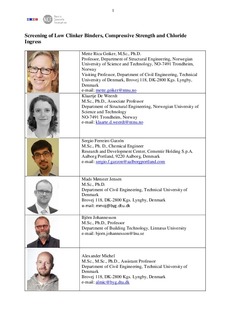| dc.contributor.author | Geiker, Mette Rica | |
| dc.contributor.author | De Weerdt, Klaartje | |
| dc.contributor.author | Ferreiro Garzón, Sergio | |
| dc.contributor.author | Jensen, Mads Mønster | |
| dc.contributor.author | Johannesson, Björn | |
| dc.contributor.author | Michel, Alexander | |
| dc.date.accessioned | 2018-03-05T12:44:51Z | |
| dc.date.available | 2018-03-05T12:44:51Z | |
| dc.date.created | 2017-12-01T16:29:46Z | |
| dc.date.issued | 2017 | |
| dc.identifier.citation | Nordic Concrete Research. 2017, 57, 23-38. | nb_NO |
| dc.identifier.issn | 0800-6377 | |
| dc.identifier.uri | http://hdl.handle.net/11250/2488637 | |
| dc.description.abstract | This paper reports an initial screening of potential new binders for concrete with reduced CO2- emission. Mortars cured saturated for 90 days are compared with regard to a) compressive strength of mortars with similar water-to-binder ratio, and b) chloride ingress in similar design strength mortars exposed to seawater. The reference used was a binder composition typical for a Danish ready mixed concrete for aggressive environments and strength class C35/45. Based on the present investigation and assumptions up to around 15% reduction in CO2 emission from binder production might be obtained without compromising the 90 days compressive strength and resistance to chloride ingress in marine exposure by using selected alternative binders. | nb_NO |
| dc.language.iso | eng | nb_NO |
| dc.publisher | Norsk Betongforening | nb_NO |
| dc.title | Screening of Low Clinker Binders, Compressive Strength and Chloride Ingress | nb_NO |
| dc.type | Journal article | nb_NO |
| dc.type | Peer reviewed | nb_NO |
| dc.description.version | acceptedVersion | nb_NO |
| dc.source.pagenumber | 23-38 | nb_NO |
| dc.source.volume | 57 | nb_NO |
| dc.source.journal | Nordic Concrete Research | nb_NO |
| dc.identifier.cristin | 1521751 | |
| dc.description.localcode | This is the authors' accepted manuscript of the article. | nb_NO |
| cristin.unitcode | 194,64,45,0 | |
| cristin.unitname | Institutt for konstruksjonsteknikk | |
| cristin.ispublished | true | |
| cristin.fulltext | postprint | |
| cristin.qualitycode | 1 | |
